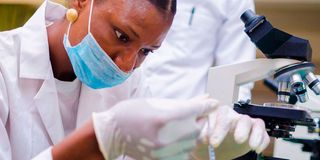Need to boost investment in health research and development

Only about 28 per cent of counties reported expenditure on health-related R&D with allocations rarely exceeding 0.02 per cent of their health budgets
Kenya is at a critical juncture on health research and development (R&D). A recent report by the Ministry of Health and Coalition for Health Research and Development (CHReaD) shows slow yet positive growth over the past five years. However, the landscape is fraught with challenges that need urgent redress to harness the full potential of health innovations. From 2019 to 2023, Kenya invested Sh90 billion ($560 million) in health R&D.
This represents a modest increase in spending as a percentage of GDP, climbing from 0.17 per cent to 0.22 per cent. Yet, these numbers barely scratch the surface of the national commitment to allocate at least 0.6 per cent of GDP to this very important area. This commitment is echoed in international pledges and the vision outlined in legislative frameworks such as the Health Act, 2017 and the Science, Technology and Innovation Act.
Despite the ambitious targets, the deployment of resources reveals a stark reliance on external funding with 75 per cent of health R&D investments sourced from international donors. This dependency underscores a critical vulnerability—our health research agenda is at the mercy of external priorities and fluctuations in global funding streams.
Commendable strides
Moreover, county governments’ involvement in health R&D remains nascent—although some have made commendable strides in setting up institutional structures for research, including research units and ethical review boards. Only about 28 per cent of counties reported expenditure on health-related R&D with allocations rarely exceeding 0.02 per cent of their health budgets.
The private sector’s engagement is equally fraught with challenges. Despite some landmark investments, such as Moderna’s initiative for developing mRNA vaccines in Kenya, bureaucratic hurdles and high costs associated with clinical trials deter broader investment. More transparent regulatory frameworks and better incentives, including tax reliefs, could catalyse private investment in health R&D. The development of HIV prevention gels and new rapid diagnostic tests for malaria are testaments to what can be achieved with targeted investment and collaboration.
The path forward requires a solid strategy to increase domestic funding for health R&D. This strategy should include redefining budgetary allocations to reflect genuine research activities rather than masking them under broad budget lines. Furthermore, a concerted effort to build capacity in the counties, engage more with the private sector and streamline regulatory processes will be essential.
For Kenya to achieve its health and development goals, particularly universal health coverage (UHC), a recalibration of our approach to health R&D investment is important. We must shift from an over-reliance on external funding to a more sustainable model that leverages increased domestic financing and private sector innovation. Only then can we truly harness the power of research to address the health challenges our nation faces.
Ms Asiko is the head of communications at Amref Health Africa in Kenya. Mr Waiganjo is the communication and advocacy technical advisor at Amref Health Africa in Kenya.





